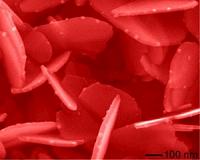 |
Raleigh NC (SPX) Mar 01, 2011 Researchers at North Carolina State University have developed a cheap and easy method for assembling nanowires, controlling their alignment and density. The researchers hope the findings will foster additional research into a range of device applications using nanowires, from nanoelectronics to nanosensors, especially on unconventional substrates such as rubber, plastic and paper. "Alignment is a critical first step for developing devices that use nanowires," says Dr. Yong Zhu, an assistant professor of mechanical and aerospace engineering at NC State and co-author of a paper describing the research. "Hopefully our simple and cost-effective method will facilitate research in this field." Aligning nanowires is challenging because, when they are created, the user is faced with a profusion of randomly oriented nanoscale wires that are, by definition, incredibly small. For example, the nanowires are between 10 and 100 nanometers in diameter, whereas a white blood cell is approximately 10,000 nanometers in diameter. Before any practical applications can be pursued, the user must assemble the nanowires in an orderly way. Specifically, users need to align the nanowires in a common direction and define their density - meaning the number of nanowires in a given area. Controlling both alignment and density is commonly called "assembling" the nanowires. In the new method, Zhu's team deposited the nanowires on a stretched rubber substrate, and then released the tension on the substrate. When the nanowires settled, they aligned at a right angle to where the tension was coming from. Picture a rubber band being stretched to the east and west. If nanowires were placed on the rubber band, and the band was allowed to snap back to its original shape, the nanowires would be oriented to the north and south. The more the rubber substrate is stretched, the more aligned the nanowires will be, and the greater the nanowire density will be. Previous research has presented a number of other methods for assembling nanowires. But the new method offers a number of distinct advantages. "Our method is cost-effective," says Feng Xu, a Ph.D. student working on this project, "because it is so simple. It can also be used for nanowires synthesized by different methods or processed in different conditions, for instance, silver nanowires synthesized in solution and silicon nanowires synthesized by the vapor-liquid-solid method, as demonstrated in our work." In addition, the new method can be used in conjunction with previous methods to achieve even better nanowire assembly. The use of a rubber substrate in this method facilitates broad research and manufacturing sectors. For example, a key element of research into stretchable nanoelectronics involves aligning nanowires on a stretchable rubber substrate. Similarly, rubber is also the material used as "stamps" in transfer printing - a critical fabrication method used in manufacturing nanodevices on diverse substrates ranging from silicon to glass to plastic. Zhu notes that the initial step of the method, when the nanowires are first deposited on stretched rubber, sometimes yields an inconsistent degree of nanowire alignment. The team is currently working to understand the fundamental interface mechanics -including adhesion and static friction -between nanowires and rubber substrates, which is expected to lead to a better control of the assembly process and hence a higher yield of the nanowire assembly. The paper, "Strain-Release Assembly of Nanowires on Stretchable Substrates," was published Feb. 22 in ACS Nano. The paper was co-authored by Zhu, Xu, NC State Ph.D. student John Durham, and Dr. Benjamin Wiley, an assistant professor at Duke University. The research was funded by the National Science Foundation. NC State's Department of Mechanical and Aerospace Engineering is part of the university's College of Engineering.
Share This Article With Planet Earth
Related Links North Carolina State University Nano Technology News From SpaceMart.com Computer Chip Architecture, Technology and Manufacture
 First Certified Reference Material For Nanoparticle Size Analysis
First Certified Reference Material For Nanoparticle Size AnalysisParis (SPX) Feb 24, 2011 Nanotechnology offers a range of benefits over traditional materials and enables the development of innovative applications and products. However, there are often concerns about the safety aspects and to what extent these have been investigated. High-quality measurements are the basis for reliable safety assessments, process improvement, quality control and the development of new nanotechnology ... read more |
|
| The content herein, unless otherwise known to be public domain, are Copyright 1995-2010 - SpaceDaily. AFP and UPI Wire Stories are copyright Agence France-Presse and United Press International. ESA Portal Reports are copyright European Space Agency. All NASA sourced material is public domain. Additional copyrights may apply in whole or part to other bona fide parties. Advertising does not imply endorsement,agreement or approval of any opinions, statements or information provided by SpaceDaily on any Web page published or hosted by SpaceDaily. Privacy Statement |